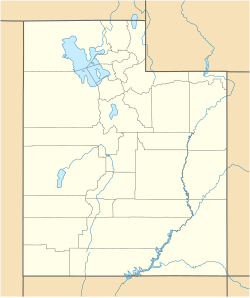Iosepa, Utah
| Iosepa | |
|---|---|
| Ghost town | |

Welcome sign at entrance to Iosepa historic site
|
|
| Location of Iosepa in Utah | |
| Coordinates: 40°32′31″N 112°44′02″W / 40.54194°N 112.73389°WCoordinates: 40°32′31″N 112°44′02″W / 40.54194°N 112.73389°W | |
| Country | United States |
| State | Utah |
| County | Tooele |
| Established | 1889 |
| Abandoned | 1917 |
| Named for | Joseph F. Smith |
| Elevation | 4,400 ft (1,341 m) |
| GNIS feature ID |
1455148 |
|
Iosepa Settlement Cemetery
|
|

Monument overlooking the Iosepa cemetery
|
|
| Location | Skull Valley, Iosepa |
| NRHP Reference # | 71000856 |
| Added to NRHP | August 12, 1971 |
1455148
Iosepa (/joʊˈsɛpə/ or /joʊˈsiːpə/, with the I like an English Y) is a ghost town in Utah's Skull Valley, located approximately 75 miles (120 km) southwest of Salt Lake City in Tooele County. Once home to over 200 Polynesian members of The Church of Jesus Christ of Latter-day Saints (LDS Church), Iosepa was inhabited during the period 1889–1917. Today it is the site of an annual Memorial Day gathering that draws islanders and others from all over the Western United States.
Mormon missionaries were sent to Polynesia starting in the 1850s. Many of their converts wanted to emigrate or "gather" to Utah with the main body of the Church, but were restricted by law, particularly in Hawaii. In the 1870s the Hawaiian government began to allow emigration, and by 1889 some 75 Native Hawaiians had gathered in the northern Salt Lake City neighborhood near Warm Springs Park. Despite their common faith, the immigrants experienced significant culture shock, as well as mistreatment by the white majority. The Polynesians were barred from staying in white-owned hotels and were refused service at restaurants in Salt Lake City. Church leaders began searching for a location to set aside as a Hawaiian enclave, but 40 years of settlement had occupied most of the desirable land in the Salt Lake area.
...
Wikipedia


